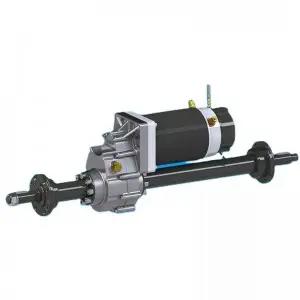The Benefits of Fewer Gears in an Electric Transaxle
Introduction
In the rapidly evolving world of automotive technology, electric vehicles (EVs) are becoming increasingly popular. One of the key components of modern EVs is the electric transaxle, which integrates the electric motor, transmission, and differential into a single unit. This innovative design offers numerous advantages, particularly when it comes to having fewer gears.
The Design and Function of Electric Transaxles
How Electric Transaxles Work
Electric transaxles operate by transferring power from the electric motor to the wheels of the vehicle. Unlike traditional internal combustion engines, which require multiple gears to achieve peak performance, electric motors can deliver high torque over a wide range of speeds. This means that fewer gears are needed to achieve the same level of performance, resulting in a more efficient and simplified transmission system.
Components of Electric Transaxles
The main components of an electric transaxle include the electric motor, the differential, and the gearbox. The electric motor provides the power, the differential allows the wheels to rotate at different speeds during turns, and the gearbox adjusts the speed and torque as needed. In electric transaxles with fewer gears, the gearbox is often designed to be more compact and efficient, further enhancing the benefits of the system.
Benefits of Fewer Gears in an Electric Transaxle
Enhanced Efficiency
One of the most significant advantages of having fewer gears in an electric transaxle is the enhanced efficiency. With fewer moving parts and a more direct energy transfer mechanism, electric transaxles can achieve higher energy transmission efficiency. This leads to improved vehicle performance and reduced power consumption, which in turn increases the overall driving range of the vehicle.
Improved Performance
Fewer gears in an electric transaxle can also contribute to improved performance. Electric motors have a broad torque range and can deliver instant torque, allowing for faster and smoother acceleration. This characteristic is particularly beneficial in urban driving scenarios, where quick bursts of speed and responsive maneuvering are essential. Additionally, fewer gears mean less interruption in power delivery, resulting in a smoother driving experience
Lower Manufacturing and Maintenance Costs
A simpler transmission system with fewer gears generally costs less to manufacture and assemble. This can potentially reduce the overall cost of the vehicle, making it more accessible to a wider range of consumers. Moreover, fewer gears mean fewer moving parts, which leads to decreased wear and tear and lower maintenance costs over time. Electric transaxles require less frequent lubricant changes and have fewer components that can fail, resulting in higher reliability and durability.
Space and Weight Savings
Electric transaxles with fewer gears are more compact and lighter than traditional transmission systems. This space-saving design allows for more efficient vehicle layouts, providing additional space for batteries or innovative interior configurations. The weight reduction also contributes to better vehicle efficiency and performance, as a lighter vehicle requires less power to move.
Environmental Impact
Electric transaxles play a crucial role in reducing the environmental impact of vehicles. By eliminating the need for fossil fuels, electric vehicles produce zero tailpipe emissions. Additionally, fewer gears in an electric transaxle contribute to lower energy consumption and reduced carbon footprint. This makes electric transaxles an important component in the global effort to achieve a more sustainable transportation system.
Case Studies and Real-World Applications
Electric Trucks
In the realm of electric trucks, the benefits of fewer gears in an electric transaxle are particularly evident. Electric motors can develop torque over a much wider speed range, allowing for high low-end torque and efficient cruising at higher speeds. For example, a two-speed transmission in an electric truck can provide sufficient power for both initial load movement and cruising, resulting in a more efficient and simplified design.
Passenger Vehicles
In passenger vehicles, electric transaxles with fewer gears offer a smoother and quieter driving experience. The absence of a traditional clutch or torque converter means that vehicles can launch smoothly from a standing stop without the need for complex gear shifting. This not only enhances comfort but also reduces driver fatigue during long drives.
Future Trends and Innovations
Advancements in Autonomous Vehicles
As the automotive industry moves towards autonomous vehicles, electric transaxles with fewer gears will play a crucial role in their development. The precise control and efficiency of electric transaxles are essential for the performance and safety of self-driving systems. Companies like Waymo and Uber are already deploying fleets of autonomous vehicles equipped with advanced electric transaxles.
Integration with Renewable Energy
The shift to electric transaxles is also driving new business models and opportunities. Companies specializing in charging infrastructure, such as ChargePoint and Electrify America, are rapidly expanding, creating jobs and contributing to a more sustainable economic ecosystem. Additionally, electric transaxles will play a pivotal role in reducing the carbon footprint of transportation when charged with renewable energy.
Conclusion
The benefits of having fewer gears in an electric transaxle are numerous and significant. Enhanced efficiency, improved performance, lower manufacturing and maintenance costs, space and weight savings, and reduced environmental impact all contribute to making electric transaxles a cornerstone of modern electric vehicle design. As technology continues to advance, electric transaxles will play an increasingly important role in shaping the future of transportation.
Post time: Jul-23-2025


